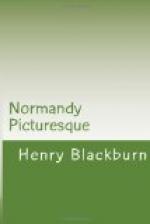The interior is 315 feet long and 81 feet high, open from one end to the other, and forms a very striking and imposing effect. ‘The west end,’ to quote a few words from the best technical authority, ’consists of florid Norman arches and piers, whose natural heaviness is relieved by the beautifully diapered patterns wrought upon the walls, probably built by Henry I., who destroyed the previously existing church by fire. Above this, runs a blank trefoiled arcade in the place of a triforium, surrounded by a clerestory of early-pointed windows, very lofty and narrow. The arches of the nave, nearest the cross and the choir, ending in a semi-circle, exhibit a more advanced state of the pointed style, and are distinguished by the remarkable elegance of their graceful clustered pillars. The circular ornaments in the spandrils of the arches are very pleasing and of fanciful variety.’
We see in the interior of this cathedral a confusion of styles—a conflict of grace and beauty with rude and grotesque work. The delicately-traced patterns carved on the walls, the medallions and pendant ornaments, in stone, of the thirteenth century, are scarcely surpassed at Chartres; side by side with these, there are headless and armless statues of the eleventh and twelfth centuries, which have been painted, and tablets (such as we have sketched) to commemorate the ancient founders of the church; and underneath the choir, the crypt of Bishop Odo, the Conqueror’s half-brother, with its twelve massive pillars, which formed the foundation of the original church, built in 1077.
[Illustration]
In the nave we may admire the beautiful radiating chapels, with their curious frescoes (some destroyed by damp and others evidently effaced by rude hands); and we may examine the bronze pulpit, with a figure of the Virgin trampling on the serpent; the dark, carved woodwork in the chancel; the old books with clasps (that Haag, or Werner, would delight in), and two quite modern stone pulpits or lecterns, with vine leaves twining up them in the form of a cross, the carving of which is equal to any of the old work—the rugged vine stem and the soft leaves being wonderfully rendered.
The interior is disfigured by some gaudy colouring under the new cupola, and the effect of the west end is, as usual, ruined by the organ loft. There are very fine stained-glass windows, some quite modern, but so good both in colour and design, that we cannot look at them without rebelling in our minds, against the conventionality of much of the modern work in english churches.[20] It seems not unreasonable to look forward to the time when it shall be accounted a sin to present caricatures of scriptural subjects in memorial church-windows. Let us rather have the kaleidescope a thousand times repeated, or the simplest diaper pattern on ground glass, than ‘Jonahs’ or ‘Daniels,’ as they are represented in these days; we are tired of the twelve apostles, so smooth and clean, in their robes of red and blue (the particular red and blue that will come best out of the melting-pot), of yellow glories and impossible temples.




